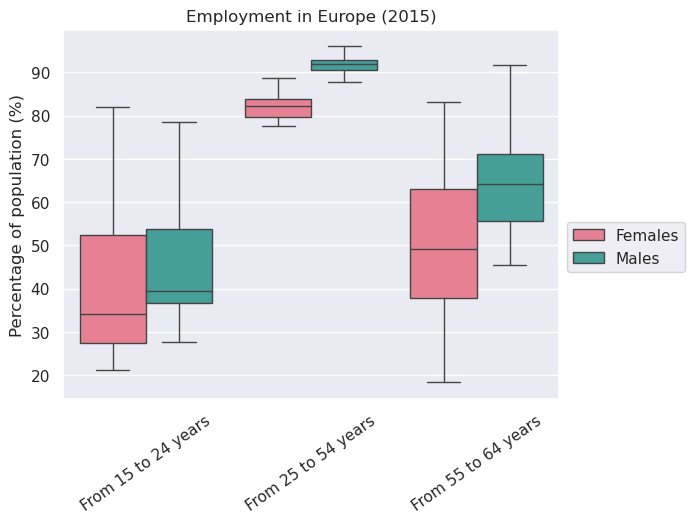17. Pandas for Panel Data#
In addition to what’s in Anaconda, this lecture will need the following libraries:
!pip install --upgrade seaborn
We use the following imports.
import matplotlib.pyplot as plt
import seaborn as sns
sns.set_theme()
17.1. Overview#
In an earlier lecture on pandas, we looked at working with simple data sets.
Econometricians often need to work with more complex data sets, such as panels.
Common tasks include
Importing data, cleaning it and reshaping it across several axes.
Selecting a time series or cross-section from a panel.
Grouping and summarizing data.
pandas (derived from ‘panel’ and ‘data’) contains powerful and
easy-to-use tools for solving exactly these kinds of problems.
In what follows, we will use a panel data set of real minimum wages from the OECD to create:
summary statistics over multiple dimensions of our data
a time series of the average minimum wage of countries in the dataset
kernel density estimates of wages by continent
We will begin by reading in our long format panel data from a CSV file and
reshaping the resulting DataFrame with pivot_table to build a MultiIndex.
Additional detail will be added to our DataFrame using pandas’
merge function, and data will be summarized with the groupby
function.
17.2. Slicing and Reshaping Data#
We will read in a dataset from the OECD of real minimum wages in 32
countries and assign it to realwage.
The dataset can be accessed with the following link:
url1 = 'https://raw.githubusercontent.com/QuantEcon/lecture-python/master/source/_static/lecture_specific/pandas_panel/realwage.csv'
import pandas as pd
# Display 6 columns for viewing purposes
pd.set_option('display.max_columns', 6)
# Reduce decimal points to 2
pd.options.display.float_format = '{:,.2f}'.format
realwage = pd.read_csv(url1)
Let’s have a look at what we’ve got to work with
realwage.head() # Show first 5 rows
| Unnamed: 0 | Time | Country | Series | Pay period | value | |
|---|---|---|---|---|---|---|
| 0 | 0 | 2006-01-01 | Ireland | In 2015 constant prices at 2015 USD PPPs | Annual | 17,132.44 |
| 1 | 1 | 2007-01-01 | Ireland | In 2015 constant prices at 2015 USD PPPs | Annual | 18,100.92 |
| 2 | 2 | 2008-01-01 | Ireland | In 2015 constant prices at 2015 USD PPPs | Annual | 17,747.41 |
| 3 | 3 | 2009-01-01 | Ireland | In 2015 constant prices at 2015 USD PPPs | Annual | 18,580.14 |
| 4 | 4 | 2010-01-01 | Ireland | In 2015 constant prices at 2015 USD PPPs | Annual | 18,755.83 |
The data is currently in long format, which is difficult to analyze when there are several dimensions to the data.
We will use pivot_table to create a wide format panel, with a MultiIndex to handle higher dimensional data.
pivot_table arguments should specify the data (values), the index, and the columns we want in our resulting dataframe.
By passing a list in columns, we can create a MultiIndex in our column axis
realwage = realwage.pivot_table(values='value',
index='Time',
columns=['Country', 'Series', 'Pay period'])
realwage.head()
| Country | Australia | ... | United States | ||||
|---|---|---|---|---|---|---|---|
| Series | In 2015 constant prices at 2015 USD PPPs | In 2015 constant prices at 2015 USD exchange rates | ... | In 2015 constant prices at 2015 USD PPPs | In 2015 constant prices at 2015 USD exchange rates | ||
| Pay period | Annual | Hourly | Annual | ... | Hourly | Annual | Hourly |
| Time | |||||||
| 2006-01-01 | 20,410.65 | 10.33 | 23,826.64 | ... | 6.05 | 12,594.40 | 6.05 |
| 2007-01-01 | 21,087.57 | 10.67 | 24,616.84 | ... | 6.24 | 12,974.40 | 6.24 |
| 2008-01-01 | 20,718.24 | 10.48 | 24,185.70 | ... | 6.78 | 14,097.56 | 6.78 |
| 2009-01-01 | 20,984.77 | 10.62 | 24,496.84 | ... | 7.58 | 15,756.42 | 7.58 |
| 2010-01-01 | 20,879.33 | 10.57 | 24,373.76 | ... | 7.88 | 16,391.31 | 7.88 |
5 rows × 128 columns
To more easily filter our time series data, later on, we will convert the index into a DateTimeIndex
realwage.index = pd.to_datetime(realwage.index)
type(realwage.index)
pandas.core.indexes.datetimes.DatetimeIndex
The columns contain multiple levels of indexing, known as a
MultiIndex, with levels being ordered hierarchically (Country >
Series > Pay period).
A MultiIndex is the simplest and most flexible way to manage panel
data in pandas
type(realwage.columns)
pandas.core.indexes.multi.MultiIndex
realwage.columns.names
FrozenList(['Country', 'Series', 'Pay period'])
Like before, we can select the country (the top level of our
MultiIndex)
realwage['United States'].head()
| Series | In 2015 constant prices at 2015 USD PPPs | In 2015 constant prices at 2015 USD exchange rates | ||
|---|---|---|---|---|
| Pay period | Annual | Hourly | Annual | Hourly |
| Time | ||||
| 2006-01-01 | 12,594.40 | 6.05 | 12,594.40 | 6.05 |
| 2007-01-01 | 12,974.40 | 6.24 | 12,974.40 | 6.24 |
| 2008-01-01 | 14,097.56 | 6.78 | 14,097.56 | 6.78 |
| 2009-01-01 | 15,756.42 | 7.58 | 15,756.42 | 7.58 |
| 2010-01-01 | 16,391.31 | 7.88 | 16,391.31 | 7.88 |
Stacking and unstacking levels of the MultiIndex will be used
throughout this lecture to reshape our dataframe into a format we need.
.stack() rotates the lowest level of the column MultiIndex to
the row index (.unstack() works in the opposite direction - try it
out)
realwage.stack(future_stack=True).head()
| Country | Australia | Belgium | ... | United Kingdom | United States | |||
|---|---|---|---|---|---|---|---|---|
| Series | In 2015 constant prices at 2015 USD PPPs | In 2015 constant prices at 2015 USD exchange rates | In 2015 constant prices at 2015 USD PPPs | ... | In 2015 constant prices at 2015 USD exchange rates | In 2015 constant prices at 2015 USD PPPs | In 2015 constant prices at 2015 USD exchange rates | |
| Time | Pay period | |||||||
| 2006-01-01 | Annual | 20,410.65 | 23,826.64 | 21,042.28 | ... | 20,376.32 | 12,594.40 | 12,594.40 |
| Hourly | 10.33 | 12.06 | 10.09 | ... | 9.81 | 6.05 | 6.05 | |
| 2007-01-01 | Annual | 21,087.57 | 24,616.84 | 21,310.05 | ... | 20,954.13 | 12,974.40 | 12,974.40 |
| Hourly | 10.67 | 12.46 | 10.22 | ... | 10.07 | 6.24 | 6.24 | |
| 2008-01-01 | Annual | 20,718.24 | 24,185.70 | 21,416.96 | ... | 20,902.87 | 14,097.56 | 14,097.56 |
5 rows × 64 columns
We can also pass in an argument to select the level we would like to stack
realwage.stack(level='Country', future_stack=True).head() # future_stack=True is required until pandas>3.0
| Series | In 2015 constant prices at 2015 USD PPPs | In 2015 constant prices at 2015 USD exchange rates | |||
|---|---|---|---|---|---|
| Pay period | Annual | Hourly | Annual | Hourly | |
| Time | Country | ||||
| 2006-01-01 | Australia | 20,410.65 | 10.33 | 23,826.64 | 12.06 |
| Belgium | 21,042.28 | 10.09 | 20,228.74 | 9.70 | |
| Brazil | 3,310.51 | 1.41 | 2,032.87 | 0.87 | |
| Canada | 13,649.69 | 6.56 | 14,335.12 | 6.89 | |
| Chile | 5,201.65 | 2.22 | 3,333.76 | 1.42 | |
Using a DatetimeIndex makes it easy to select a particular time
period.
Selecting one year and stacking the two lower levels of the
MultiIndex creates a cross-section of our panel data
realwage.loc['2015'].stack(level=(1, 2), future_stack=True).transpose().head() # future_stack=True is required until pandas>3.0
| Time | 2015-01-01 | |||
|---|---|---|---|---|
| Series | In 2015 constant prices at 2015 USD PPPs | In 2015 constant prices at 2015 USD exchange rates | ||
| Pay period | Annual | Hourly | Annual | Hourly |
| Country | ||||
| Australia | 21,715.53 | 10.99 | 25,349.90 | 12.83 |
| Belgium | 21,588.12 | 10.35 | 20,753.48 | 9.95 |
| Brazil | 4,628.63 | 2.00 | 2,842.28 | 1.21 |
| Canada | 16,536.83 | 7.95 | 17,367.24 | 8.35 |
| Chile | 6,633.56 | 2.80 | 4,251.49 | 1.81 |
For the rest of lecture, we will work with a dataframe of the hourly real minimum wages across countries and time, measured in 2015 US dollars.
To create our filtered dataframe (realwage_f), we can use the xs
method to select values at lower levels in the multiindex, while keeping
the higher levels (countries in this case)
realwage_f = realwage.xs(('Hourly', 'In 2015 constant prices at 2015 USD exchange rates'),
level=('Pay period', 'Series'), axis=1)
realwage_f.head()
| Country | Australia | Belgium | Brazil | ... | Turkey | United Kingdom | United States |
|---|---|---|---|---|---|---|---|
| Time | |||||||
| 2006-01-01 | 12.06 | 9.70 | 0.87 | ... | 2.27 | 9.81 | 6.05 |
| 2007-01-01 | 12.46 | 9.82 | 0.92 | ... | 2.26 | 10.07 | 6.24 |
| 2008-01-01 | 12.24 | 9.87 | 0.96 | ... | 2.22 | 10.04 | 6.78 |
| 2009-01-01 | 12.40 | 10.21 | 1.03 | ... | 2.28 | 10.15 | 7.58 |
| 2010-01-01 | 12.34 | 10.05 | 1.08 | ... | 2.30 | 9.96 | 7.88 |
5 rows × 32 columns
17.3. Merging Dataframes and Filling NaNs#
Similar to relational databases like SQL, pandas has built in methods to merge datasets together.
Using country information from
WorldData.info, we’ll add
the continent of each country to realwage_f with the merge
function.
The dataset can be accessed with the following link:
url2 = 'https://raw.githubusercontent.com/QuantEcon/lecture-python/master/source/_static/lecture_specific/pandas_panel/countries.csv'
worlddata = pd.read_csv(url2, sep=';')
worlddata.head()
| Country (en) | Country (de) | Country (local) | ... | Deathrate | Life expectancy | Url | |
|---|---|---|---|---|---|---|---|
| 0 | Afghanistan | Afghanistan | Afganistan/Afqanestan | ... | 13.70 | 51.30 | https://www.laenderdaten.info/Asien/Afghanista... |
| 1 | Egypt | Ägypten | Misr | ... | 4.70 | 72.70 | https://www.laenderdaten.info/Afrika/Aegypten/... |
| 2 | Åland Islands | Ålandinseln | Åland | ... | 0.00 | 0.00 | https://www.laenderdaten.info/Europa/Aland/ind... |
| 3 | Albania | Albanien | Shqipëria | ... | 6.70 | 78.30 | https://www.laenderdaten.info/Europa/Albanien/... |
| 4 | Algeria | Algerien | Al-Jaza’ir/Algérie | ... | 4.30 | 76.80 | https://www.laenderdaten.info/Afrika/Algerien/... |
5 rows × 17 columns
First, we’ll select just the country and continent variables from
worlddata and rename the column to ‘Country’
worlddata = worlddata[['Country (en)', 'Continent']]
worlddata = worlddata.rename(columns={'Country (en)': 'Country'})
worlddata.head()
| Country | Continent | |
|---|---|---|
| 0 | Afghanistan | Asia |
| 1 | Egypt | Africa |
| 2 | Åland Islands | Europe |
| 3 | Albania | Europe |
| 4 | Algeria | Africa |
We want to merge our new dataframe, worlddata, with realwage_f.
The pandas merge function allows dataframes to be joined together by
rows.
Our dataframes will be merged using country names, requiring us to use
the transpose of realwage_f so that rows correspond to country names
in both dataframes
realwage_f.transpose().head()
| Time | 2006-01-01 | 2007-01-01 | 2008-01-01 | ... | 2014-01-01 | 2015-01-01 | 2016-01-01 |
|---|---|---|---|---|---|---|---|
| Country | |||||||
| Australia | 12.06 | 12.46 | 12.24 | ... | 12.67 | 12.83 | 12.98 |
| Belgium | 9.70 | 9.82 | 9.87 | ... | 10.01 | 9.95 | 9.76 |
| Brazil | 0.87 | 0.92 | 0.96 | ... | 1.21 | 1.21 | 1.24 |
| Canada | 6.89 | 6.96 | 7.24 | ... | 8.22 | 8.35 | 8.48 |
| Chile | 1.42 | 1.45 | 1.44 | ... | 1.76 | 1.81 | 1.91 |
5 rows × 11 columns
We can use either left, right, inner, or outer join to merge our datasets:
left join includes only countries from the left dataset
right join includes only countries from the right dataset
outer join includes countries that are in either the left and right datasets
inner join includes only countries common to both the left and right datasets
By default, merge will use an inner join.
Here we will pass how='left' to keep all countries in
realwage_f, but discard countries in worlddata that do not have
a corresponding data entry realwage_f.
This is illustrated by the red shading in the following diagram
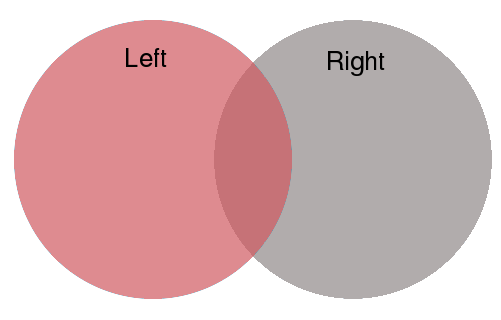
We will also need to specify where the country name is located in each
dataframe, which will be the key that is used to merge the
dataframes ‘on’.
Our ‘left’ dataframe (realwage_f.transpose()) contains countries in
the index, so we set left_index=True.
Our ‘right’ dataframe (worlddata) contains countries in the
‘Country’ column, so we set right_on='Country'
merged = pd.merge(realwage_f.transpose(), worlddata,
how='left', left_index=True, right_on='Country')
merged.head()
| 2006-01-01 00:00:00 | 2007-01-01 00:00:00 | 2008-01-01 00:00:00 | ... | 2016-01-01 00:00:00 | Country | Continent | |
|---|---|---|---|---|---|---|---|
| 17.00 | 12.06 | 12.46 | 12.24 | ... | 12.98 | Australia | Australia |
| 23.00 | 9.70 | 9.82 | 9.87 | ... | 9.76 | Belgium | Europe |
| 32.00 | 0.87 | 0.92 | 0.96 | ... | 1.24 | Brazil | South America |
| 100.00 | 6.89 | 6.96 | 7.24 | ... | 8.48 | Canada | North America |
| 38.00 | 1.42 | 1.45 | 1.44 | ... | 1.91 | Chile | South America |
5 rows × 13 columns
Countries that appeared in realwage_f but not in worlddata will
have NaN in the Continent column.
To check whether this has occurred, we can use .isnull() on the
continent column and filter the merged dataframe
merged[merged['Continent'].isnull()]
| 2006-01-01 00:00:00 | 2007-01-01 00:00:00 | 2008-01-01 00:00:00 | ... | 2016-01-01 00:00:00 | Country | Continent | |
|---|---|---|---|---|---|---|---|
| NaN | 3.42 | 3.74 | 3.87 | ... | 5.28 | Korea | NaN |
| NaN | 0.23 | 0.45 | 0.39 | ... | 0.55 | Russian Federation | NaN |
| NaN | 1.50 | 1.64 | 1.71 | ... | 2.08 | Slovak Republic | NaN |
3 rows × 13 columns
We have three missing values!
One option to deal with NaN values is to create a dictionary containing these countries and their respective continents.
.map() will match countries in merged['Country'] with their
continent from the dictionary.
Notice how countries not in our dictionary are mapped with NaN
missing_continents = {'Korea': 'Asia',
'Russian Federation': 'Europe',
'Slovak Republic': 'Europe'}
merged['Country'].map(missing_continents)
17.00 NaN
23.00 NaN
32.00 NaN
100.00 NaN
38.00 NaN
108.00 NaN
41.00 NaN
225.00 NaN
53.00 NaN
58.00 NaN
45.00 NaN
68.00 NaN
233.00 NaN
86.00 NaN
88.00 NaN
91.00 NaN
NaN Asia
117.00 NaN
122.00 NaN
123.00 NaN
138.00 NaN
153.00 NaN
151.00 NaN
174.00 NaN
175.00 NaN
NaN Europe
NaN Europe
198.00 NaN
200.00 NaN
227.00 NaN
241.00 NaN
240.00 NaN
Name: Country, dtype: object
We don’t want to overwrite the entire series with this mapping.
.fillna() only fills in NaN values in merged['Continent']
with the mapping, while leaving other values in the column unchanged
merged['Continent'] = merged['Continent'].fillna(merged['Country'].map(missing_continents))
# Check for whether continents were correctly mapped
merged[merged['Country'] == 'Korea']
| 2006-01-01 00:00:00 | 2007-01-01 00:00:00 | 2008-01-01 00:00:00 | ... | 2016-01-01 00:00:00 | Country | Continent | |
|---|---|---|---|---|---|---|---|
| NaN | 3.42 | 3.74 | 3.87 | ... | 5.28 | Korea | Asia |
1 rows × 13 columns
We will also combine the Americas into a single continent - this will make our visualization nicer later on.
To do this, we will use .replace() and loop through a list of the continent values we want to replace
replace = ['Central America', 'North America', 'South America']
merged['Continent'] = merged['Continent'].replace(to_replace=replace, value='America')
Now that we have all the data we want in a single DataFrame, we will
reshape it back into panel form with a MultiIndex.
We should also ensure to sort the index using .sort_index() so that we
can efficiently filter our dataframe later on.
By default, levels will be sorted top-down
merged = merged.set_index(['Continent', 'Country']).sort_index()
merged.head()
| 2006-01-01 | 2007-01-01 | 2008-01-01 | ... | 2014-01-01 | 2015-01-01 | 2016-01-01 | ||
|---|---|---|---|---|---|---|---|---|
| Continent | Country | |||||||
| America | Brazil | 0.87 | 0.92 | 0.96 | ... | 1.21 | 1.21 | 1.24 |
| Canada | 6.89 | 6.96 | 7.24 | ... | 8.22 | 8.35 | 8.48 | |
| Chile | 1.42 | 1.45 | 1.44 | ... | 1.76 | 1.81 | 1.91 | |
| Colombia | 1.01 | 1.02 | 1.01 | ... | 1.13 | 1.13 | 1.12 | |
| Costa Rica | NaN | NaN | NaN | ... | 2.41 | 2.56 | 2.63 |
5 rows × 11 columns
While merging, we lost our DatetimeIndex, as we merged columns that
were not in datetime format
merged.columns
Index([2006-01-01 00:00:00, 2007-01-01 00:00:00, 2008-01-01 00:00:00,
2009-01-01 00:00:00, 2010-01-01 00:00:00, 2011-01-01 00:00:00,
2012-01-01 00:00:00, 2013-01-01 00:00:00, 2014-01-01 00:00:00,
2015-01-01 00:00:00, 2016-01-01 00:00:00],
dtype='object')
Now that we have set the merged columns as the index, we can recreate a
DatetimeIndex using .to_datetime()
merged.columns = pd.to_datetime(merged.columns)
merged.columns = merged.columns.rename('Time')
merged.columns
DatetimeIndex(['2006-01-01', '2007-01-01', '2008-01-01', '2009-01-01',
'2010-01-01', '2011-01-01', '2012-01-01', '2013-01-01',
'2014-01-01', '2015-01-01', '2016-01-01'],
dtype='datetime64[ns]', name='Time', freq=None)
The DatetimeIndex tends to work more smoothly in the row axis, so we
will go ahead and transpose merged
merged = merged.transpose()
merged.head()
| Continent | America | ... | Europe | ||||
|---|---|---|---|---|---|---|---|
| Country | Brazil | Canada | Chile | ... | Slovenia | Spain | United Kingdom |
| Time | |||||||
| 2006-01-01 | 0.87 | 6.89 | 1.42 | ... | 3.92 | 3.99 | 9.81 |
| 2007-01-01 | 0.92 | 6.96 | 1.45 | ... | 3.88 | 4.10 | 10.07 |
| 2008-01-01 | 0.96 | 7.24 | 1.44 | ... | 3.96 | 4.14 | 10.04 |
| 2009-01-01 | 1.03 | 7.67 | 1.52 | ... | 4.08 | 4.32 | 10.15 |
| 2010-01-01 | 1.08 | 7.94 | 1.56 | ... | 4.81 | 4.30 | 9.96 |
5 rows × 32 columns
17.4. Grouping and Summarizing Data#
Grouping and summarizing data can be particularly useful for understanding large panel datasets.
A simple way to summarize data is to call an aggregation
method
on the dataframe, such as .mean() or .max().
For example, we can calculate the average real minimum wage for each country over the period 2006 to 2016 (the default is to aggregate over rows)
merged.mean().head(10)
Continent Country
America Brazil 1.09
Canada 7.82
Chile 1.62
Colombia 1.07
Costa Rica 2.53
Mexico 0.53
United States 7.15
Asia Israel 5.95
Japan 6.18
Korea 4.22
dtype: float64
Using this series, we can plot the average real minimum wage over the past decade for each country in our data set
merged.mean().sort_values(ascending=False).plot(kind='bar',
title="Average real minimum wage 2006 - 2016")
# Set country labels
country_labels = merged.mean().sort_values(ascending=False).index.get_level_values('Country').tolist()
plt.xticks(range(0, len(country_labels)), country_labels)
plt.xlabel('Country')
plt.show()
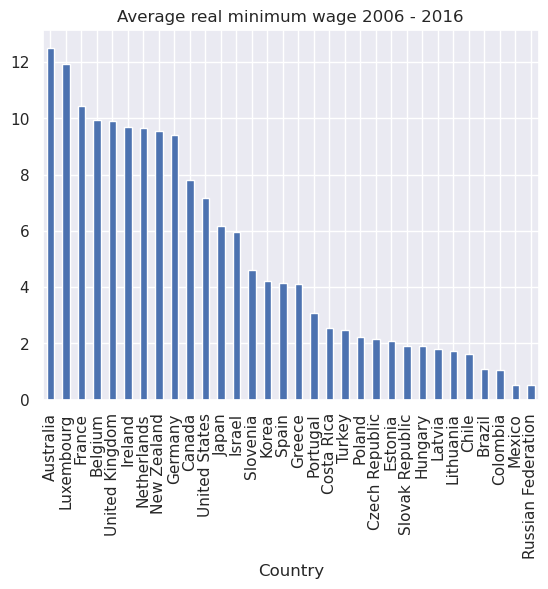
Passing in axis=1 to .mean() will aggregate over columns (giving
the average minimum wage for all countries over time)
merged.mean(axis=1).head()
Time
2006-01-01 4.69
2007-01-01 4.84
2008-01-01 4.90
2009-01-01 5.08
2010-01-01 5.11
dtype: float64
We can plot this time series as a line graph
merged.mean(axis=1).plot()
plt.title('Average real minimum wage 2006 - 2016')
plt.ylabel('2015 USD')
plt.xlabel('Year')
plt.show()
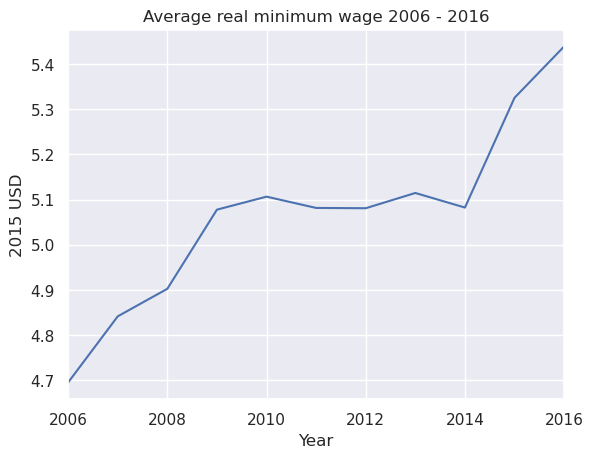
We can also specify a level of the MultiIndex (in the column axis)
to aggregate over.
In the case of groupby we need to use .T to transpose the columns into rows as pandas has deprecated the use of axis=1 in the groupby method.
merged.T.groupby(level='Continent').mean().head()
| Time | 2006-01-01 | 2007-01-01 | 2008-01-01 | ... | 2014-01-01 | 2015-01-01 | 2016-01-01 |
|---|---|---|---|---|---|---|---|
| Continent | |||||||
| America | 2.80 | 2.85 | 2.99 | ... | 3.22 | 3.26 | 3.30 |
| Asia | 4.29 | 4.44 | 4.45 | ... | 4.86 | 5.10 | 5.44 |
| Australia | 10.25 | 10.73 | 10.76 | ... | 11.25 | 11.52 | 11.73 |
| Europe | 4.80 | 4.94 | 4.99 | ... | 5.17 | 5.48 | 5.57 |
4 rows × 11 columns
We can plot the average minimum wages in each continent as a time series
merged.T.groupby(level='Continent').mean().T.plot()
plt.title('Average real minimum wage')
plt.ylabel('2015 USD')
plt.xlabel('Year')
plt.show()
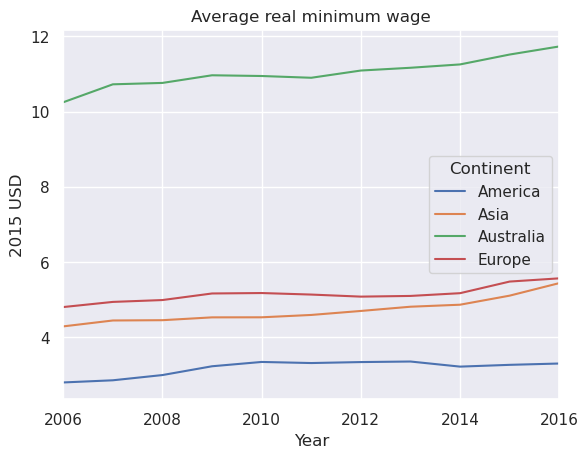
We will drop Australia as a continent for plotting purposes
merged = merged.drop('Australia', level='Continent', axis=1)
merged.T.groupby(level='Continent').mean().T.plot()
plt.title('Average real minimum wage')
plt.ylabel('2015 USD')
plt.xlabel('Year')
plt.show()
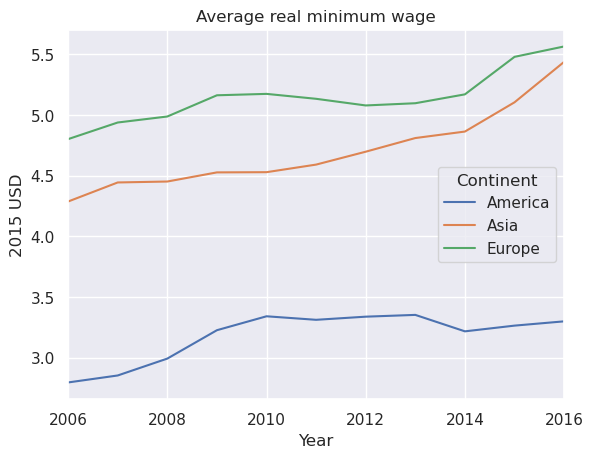
.describe() is useful for quickly retrieving a number of common
summary statistics
merged.stack(future_stack=True).describe()
| Continent | America | Asia | Europe |
|---|---|---|---|
| count | 69.00 | 44.00 | 200.00 |
| mean | 3.19 | 4.70 | 5.15 |
| std | 3.02 | 1.56 | 3.82 |
| min | 0.52 | 2.22 | 0.23 |
| 25% | 1.03 | 3.37 | 2.02 |
| 50% | 1.44 | 5.48 | 3.54 |
| 75% | 6.96 | 5.95 | 9.70 |
| max | 8.48 | 6.65 | 12.39 |
This is a simplified way to use groupby.
Using groupby generally follows a ‘split-apply-combine’ process:
split: data is grouped based on one or more keys
apply: a function is called on each group independently
combine: the results of the function calls are combined into a new data structure
The groupby method achieves the first step of this process, creating
a new DataFrameGroupBy object with data split into groups.
Let’s split merged by continent again, this time using the
groupby function, and name the resulting object grouped
grouped = merged.T.groupby(level='Continent')
grouped
<pandas.core.groupby.generic.DataFrameGroupBy object at 0x7cb34effb820>
Calling an aggregation method on the object applies the function to each group, the results of which are combined in a new data structure.
For example, we can return the number of countries in our dataset for
each continent using .size().
In this case, our new data structure is a Series
grouped.size()
Continent
America 7
Asia 4
Europe 19
dtype: int64
Calling .get_group() to return just the countries in a single group,
we can create a kernel density estimate of the distribution of real
minimum wages in 2016 for each continent.
grouped.groups.keys() will return the keys from the groupby
object
continents = grouped.groups.keys()
for continent in continents:
sns.kdeplot(grouped.get_group(continent).T.loc['2015'].unstack(), label=continent, fill=True)
plt.title('Real minimum wages in 2015')
plt.xlabel('US dollars')
plt.legend()
plt.show()
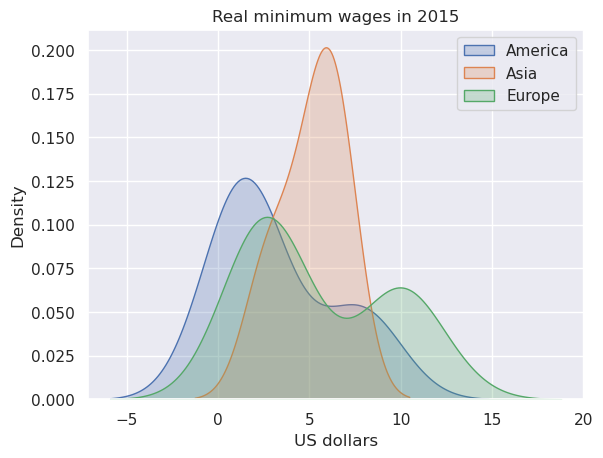
17.5. Final Remarks#
This lecture has provided an introduction to some of pandas’ more advanced features, including multiindices, merging, grouping and plotting.
Other tools that may be useful in panel data analysis include xarray, a python package that extends pandas to N-dimensional data structures.
17.6. Exercises#
Exercise 17.1
In these exercises, you’ll work with a dataset of employment rates in Europe by age and sex from Eurostat.
The dataset can be accessed with the following link:
url3 = 'https://raw.githubusercontent.com/QuantEcon/lecture-python/master/source/_static/lecture_specific/pandas_panel/employ.csv'
Reading in the CSV file returns a panel dataset in long format. Use .pivot_table() to construct
a wide format dataframe with a MultiIndex in the columns.
Start off by exploring the dataframe and the variables available in the
MultiIndex levels.
Write a program that quickly returns all values in the MultiIndex.
Solution
employ = pd.read_csv(url3)
employ = employ.pivot_table(values='Value',
index=['DATE'],
columns=['UNIT','AGE', 'SEX', 'INDIC_EM', 'GEO'])
employ.index = pd.to_datetime(employ.index) # ensure that dates are datetime format
employ.head()
| UNIT | Percentage of total population | ... | Thousand persons | ||||
|---|---|---|---|---|---|---|---|
| AGE | From 15 to 24 years | ... | From 55 to 64 years | ||||
| SEX | Females | ... | Total | ||||
| INDIC_EM | Active population | ... | Total employment (resident population concept - LFS) | ||||
| GEO | Austria | Belgium | Bulgaria | ... | Switzerland | Turkey | United Kingdom |
| DATE | |||||||
| 2007-01-01 | 56.00 | 31.60 | 26.00 | ... | NaN | 1,282.00 | 4,131.00 |
| 2008-01-01 | 56.20 | 30.80 | 26.10 | ... | NaN | 1,354.00 | 4,204.00 |
| 2009-01-01 | 56.20 | 29.90 | 24.80 | ... | NaN | 1,449.00 | 4,193.00 |
| 2010-01-01 | 54.00 | 29.80 | 26.60 | ... | 640.00 | 1,583.00 | 4,186.00 |
| 2011-01-01 | 54.80 | 29.80 | 24.80 | ... | 661.00 | 1,760.00 | 4,164.00 |
5 rows × 1440 columns
This is a large dataset so it is useful to explore the levels and variables available
employ.columns.names
FrozenList(['UNIT', 'AGE', 'SEX', 'INDIC_EM', 'GEO'])
Variables within levels can be quickly retrieved with a loop
for name in employ.columns.names:
print(name, employ.columns.get_level_values(name).unique())
UNIT Index(['Percentage of total population', 'Thousand persons'], dtype='object', name='UNIT')
AGE Index(['From 15 to 24 years', 'From 25 to 54 years', 'From 55 to 64 years'], dtype='object', name='AGE')
SEX Index(['Females', 'Males', 'Total'], dtype='object', name='SEX')
INDIC_EM Index(['Active population', 'Total employment (resident population concept - LFS)'], dtype='object', name='INDIC_EM')
GEO Index(['Austria', 'Belgium', 'Bulgaria', 'Croatia', 'Cyprus', 'Czech Republic',
'Denmark', 'Estonia', 'Euro area (17 countries)',
'Euro area (18 countries)', 'Euro area (19 countries)',
'European Union (15 countries)', 'European Union (27 countries)',
'European Union (28 countries)', 'Finland',
'Former Yugoslav Republic of Macedonia, the', 'France',
'France (metropolitan)',
'Germany (until 1990 former territory of the FRG)', 'Greece', 'Hungary',
'Iceland', 'Ireland', 'Italy', 'Latvia', 'Lithuania', 'Luxembourg',
'Malta', 'Netherlands', 'Norway', 'Poland', 'Portugal', 'Romania',
'Slovakia', 'Slovenia', 'Spain', 'Sweden', 'Switzerland', 'Turkey',
'United Kingdom'],
dtype='object', name='GEO')
Exercise 17.2
Filter the above dataframe to only include employment as a percentage of ‘active population’.
Create a grouped boxplot using seaborn of employment rates in 2015
by age group and sex.
Hint
GEO includes both areas and countries.
Solution
To easily filter by country, swap GEO to the top level and sort the
MultiIndex
employ.columns = employ.columns.swaplevel(0,-1)
employ = employ.sort_index(axis=1)
We need to get rid of a few items in GEO which are not countries.
A fast way to get rid of the EU areas is to use a list comprehension to
find the level values in GEO that begin with ‘Euro’
geo_list = employ.columns.get_level_values('GEO').unique().tolist()
countries = [x for x in geo_list if not x.startswith('Euro')]
employ = employ[countries]
employ.columns.get_level_values('GEO').unique()
Index(['Austria', 'Belgium', 'Bulgaria', 'Croatia', 'Cyprus', 'Czech Republic',
'Denmark', 'Estonia', 'Finland',
'Former Yugoslav Republic of Macedonia, the', 'France',
'France (metropolitan)',
'Germany (until 1990 former territory of the FRG)', 'Greece', 'Hungary',
'Iceland', 'Ireland', 'Italy', 'Latvia', 'Lithuania', 'Luxembourg',
'Malta', 'Netherlands', 'Norway', 'Poland', 'Portugal', 'Romania',
'Slovakia', 'Slovenia', 'Spain', 'Sweden', 'Switzerland', 'Turkey',
'United Kingdom'],
dtype='object', name='GEO')
Select only percentage employed in the active population from the dataframe
employ_f = employ.xs(('Percentage of total population', 'Active population'),
level=('UNIT', 'INDIC_EM'),
axis=1)
employ_f.head()
| GEO | Austria | ... | United Kingdom | ||||
|---|---|---|---|---|---|---|---|
| AGE | From 15 to 24 years | ... | From 55 to 64 years | ||||
| SEX | Females | Males | Total | ... | Females | Males | Total |
| DATE | |||||||
| 2007-01-01 | 56.00 | 62.90 | 59.40 | ... | 49.90 | 68.90 | 59.30 |
| 2008-01-01 | 56.20 | 62.90 | 59.50 | ... | 50.20 | 69.80 | 59.80 |
| 2009-01-01 | 56.20 | 62.90 | 59.50 | ... | 50.60 | 70.30 | 60.30 |
| 2010-01-01 | 54.00 | 62.60 | 58.30 | ... | 51.10 | 69.20 | 60.00 |
| 2011-01-01 | 54.80 | 63.60 | 59.20 | ... | 51.30 | 68.40 | 59.70 |
5 rows × 306 columns
Drop the ‘Total’ value before creating the grouped boxplot
employ_f = employ_f.drop('Total', level='SEX', axis=1)
box = employ_f.loc['2015'].unstack().reset_index()
sns.boxplot(x="AGE", y=0, hue="SEX", data=box, palette=("husl"), showfliers=False)
plt.xlabel('')
plt.xticks(rotation=35)
plt.ylabel('Percentage of population (%)')
plt.title('Employment in Europe (2015)')
plt.legend(bbox_to_anchor=(1,0.5))
plt.show()
